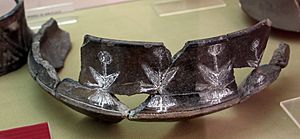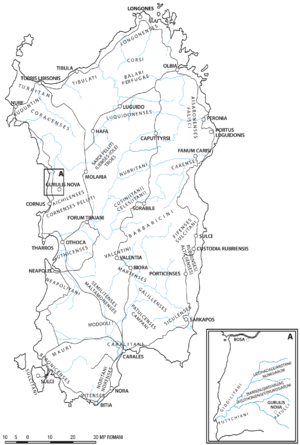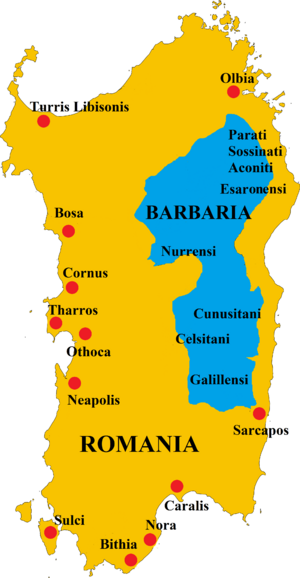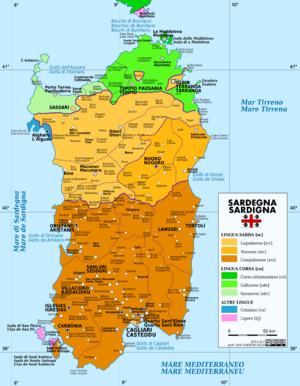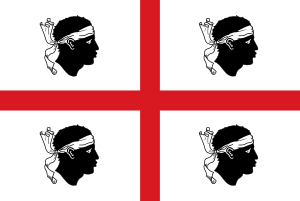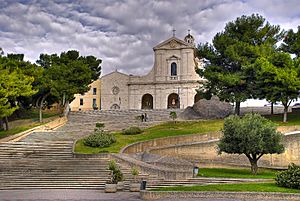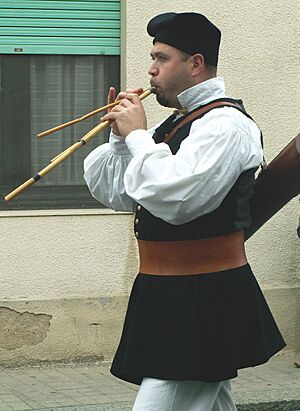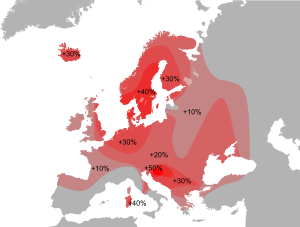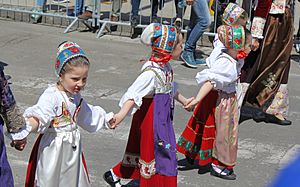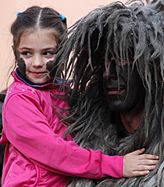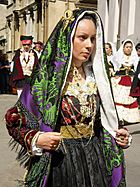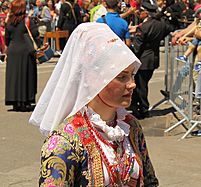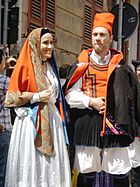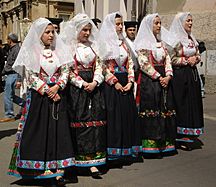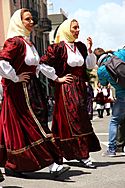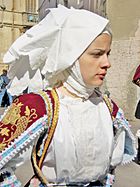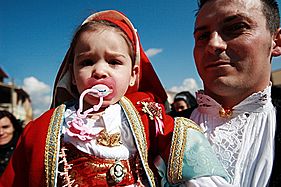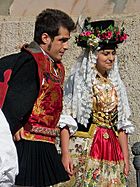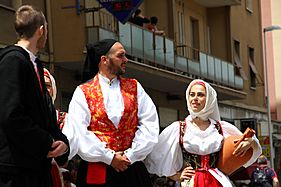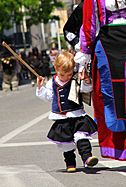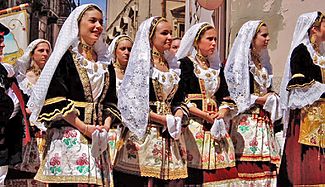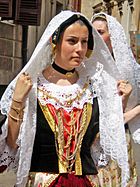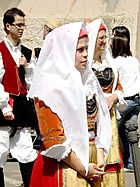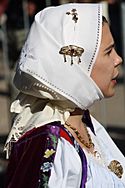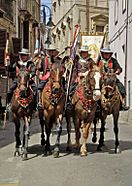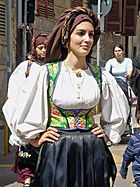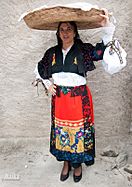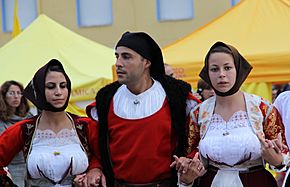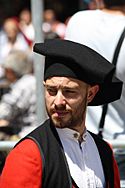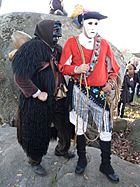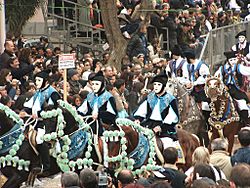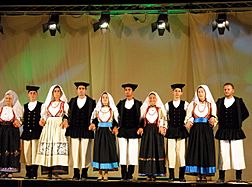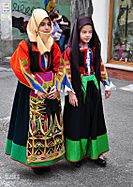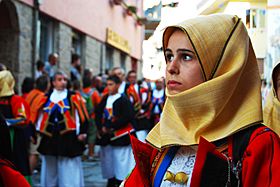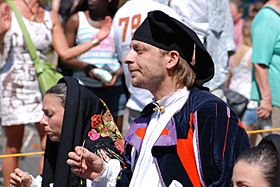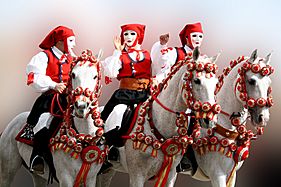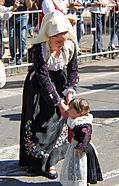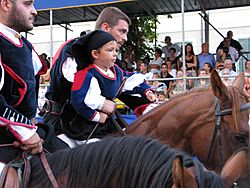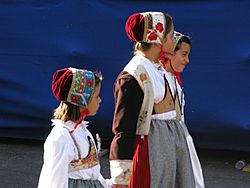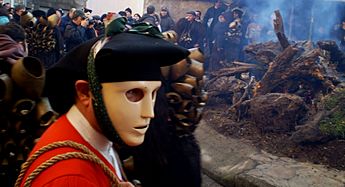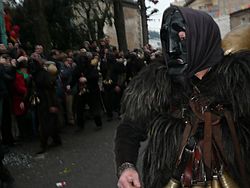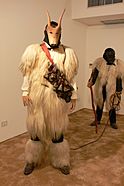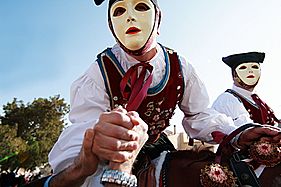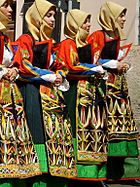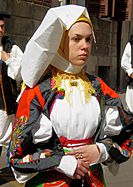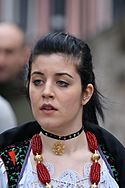Sardinian people facts for kids
| Sardos / Sardus (Sardinian) Sardi (Italian) |
|
|---|---|
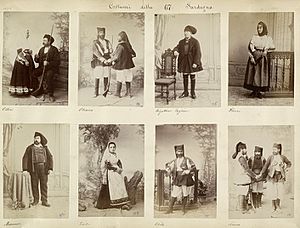
Sardinian people and their traditional regional attires in 1880s
|
|
| Regions with significant populations | |
(Inhabitants of Sardinia inclusive of all ethnicities) |
|
| 2.250.000 (outside Sardinia) | |
| Languages | |
| Italian • Sardinian | |
| Religion | |
| mostly Christian (predominantly Roman Catholicism) | |
| Related ethnic groups | |
| Spaniards, Italians, Corsicans |
The Sardinians, also called Sards, are a group of people who speak Romance languages. They are originally from Sardinia, a large island in the western Mediterranean Sea. This island is also an autonomous region of Italy and gets its name from its people.
Contents
Where Does the Name "Sardinian" Come From?
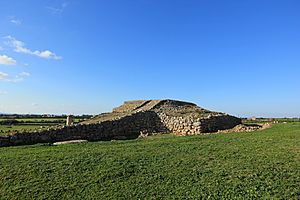
Historians don't know for sure where the name "Sard" came from. It's a very old word, even older than the Indo-European languages. Some ancient writers thought the name came from "Sardò," a legendary woman from Sardis in what is now Turkey.
Other writers, like Pausanias, said that Sardinians believed they came from a mythical ancestor. This ancestor was a Libyan son of Hercules, known as Sardus Pater Babai. This name means "Sardinian Father" or "Father of the Sardinians." He is said to have given the island its name. Some people also think the ancient Sardinians were connected to the Sherden, who were part of the mysterious Sea Peoples mentioned in ancient Egyptian records. Later, the Romans changed the name to sardus (for men) and sarda (for women).
A Look Back in Time: Sardinian History
Early Times: Prehistory
Sardinia was first settled by people from Europe during the Stone Age. Later, in the Neolithic period, early farmers from Italy, Spain, and the Aegean area moved to the island. Around the Bronze Age, people from Southern France and Northern Spain also settled there. They brought new ways of working with metal and making pottery.
The Nuragic Civilization
The amazing Nuragic civilization started in the Middle Bronze Age. During this time, Sardinians began to feel like one people. They were divided into three main tribes: the Iolei (or Ilienses) in the south, the Balares in the northwest, and the Corsi in the north. Some experts believe the Nuragic Sardinians were linked to the Sherden, a group of "Sea Peoples" mentioned in ancient Egyptian writings.
We don't know what language the Nuragic people spoke because they didn't leave written records. Some scholars think it was similar to Proto-Basque or Etruscan. Others believe there might have been several languages spoken on the island.
Ancient Times

Around 800 BC, the Phoenicians built cities and ports along the coast of Sardinia. Places like Cagliari and Tharros started this way. Later, in the late 6th century BC, the Carthaginians took over the southern and western parts of the island. The native Sardinians and the Punic-Berber people from North Africa shared many cultural similarities for a long time.
After the First Punic War, the Romans conquered Sardinia in the 3rd century BC. It took them over 150 years to fully control the fierce Nuragic tribes living inland. Even after 184 years of Roman rule, some Sardinian communities still resisted. The Romans didn't like Sardinia much, and it was kept quite isolated. Because of this, Roman culture spread slowly.
During Roman rule, many people from the Italian peninsula moved to Sardinia. However, they often had trouble getting along with the native Sardinians. The inner, mountainous areas were even called Barbaria (meaning "Land of the Barbarians"). This showed how independent the tribes there were. They even kept their old religions until the time of Pope Gregory I. Still, over time, Sardinian culture became more Roman. The modern Sardinian language is a good example of this change.
Middle Ages
After the Western Roman Empire fell, Sardinia was ruled by different groups, including the Vandals and the Byzantines. When Arabs conquered North Africa, many Berbers moved to Sardinia as refugees and became part of the Sardinian people.
In the Middle Ages, Sardinia was divided into four independent kingdoms. Most of these kingdoms were influenced by the powerful Italian cities of Genoa and Pisa. Genoese families founded cities like Alghero, and Pisans founded Cagliari.
Later, the Crown of Aragon from Spain conquered parts of Sardinia. After a long war, the Kingdom of Sardinia became part of the Crown of Aragon. The Aragonese brought many Catalans to live in cities like Cagliari and Alghero. A local dialect of Catalan is still spoken in Alghero today.
Modern and Recent History
In the 16th and 17th centuries, Sardinian cities like Cagliari and Sassari were important trading hubs. People from Spain, France, and especially Corsica lived there. Many Corsicans moved to the northern parts of Sardinia, which likely led to the development of the Sassarese and Gallurese dialects.
Spanish rule ended in 1713. Sardinia was then given to the Austrian House of Habsburg, and later to the Dukes of Savoy in 1718. The Savoy family, who ruled from Turin, became "Kings of Sardinia." They tried to make the islanders more like people from mainland Italy. In 1738, people from Liguria (Italy) who had escaped from Tunisia were invited to settle on small islands near Sardinia. They brought their own Ligurian dialect, called "Tabarchino," which is still spoken there. Later, in 1861, the Savoyard Kingdom of Sardinia united all of Italy, becoming the Kingdom of Italy.
From 1850 onwards, many miners from mainland Italy moved to the mining areas of Sardinia. They came from places like Lombardy and Tuscany. By 1882, about 10,000 miners worked in southern Sardinia, with one-third from the mainland.
At the end of the 19th century, fishermen from Sicily and other parts of Italy settled on the east coast of Sardinia.
In 1931, only a small percentage of Sardinia's population was from the mainland. However, the Fascist government encouraged more Italians to move to Sardinia. They founded new towns like Carbonia. After World War II, Italian refugees from other areas also moved to Sardinia. As a result, Carbonia developed its own mix of Italian and Sardinian.
More recently, many Sardinians have moved from the island's interior to the coastal cities like Cagliari and Olbia. This is where most Sardinians live today.
How Many Sardinians Are There?
Sardinia is one of the least populated regions in Italy. Unlike other coastal areas, most people historically lived inland. This was because of attacks from the sea during the Middle Ages and the swampy coastal areas. Like Celtic clans, Sardinians often moved to less accessible areas to keep their independence. Today, however, more people live near the coast due to tourism.
Sardinia has a very low birth rate. However, its population has grown recently due to people moving there from mainland Italy, Sicily, and other countries like Romania.
Long Lives in Sardinia
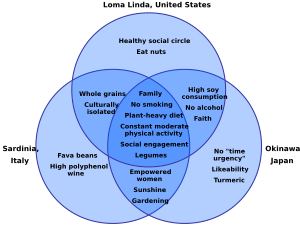
Sardinians live a long time! The average life expectancy is over 82 years. Sardinia is known as the first "Blue Zone." These are places where people live much longer than average. Sardinians have one of the highest rates of centenarians (people over 100 years old) in the world. This is thought to be due to their genes, healthy lifestyles, and strong community ties.
Where Sardinians Live Today
Most Sardinians live on the island itself. However, many have moved outside Sardinia. Between 1955 and 1971, about 308,000 Sardinians moved to mainland Italy. Large Sardinian communities can be found in Piedmont, Liguria, and Lombardy.
Many Sardinians and their families also live in Germany, France, Belgium, Switzerland, and the USA. In the past, many moved to South America, especially Argentina and Uruguay. Some also went to Algeria and Tunisia in Africa.
The Region of Sardinia helps Sardinians living abroad stay connected to their culture. There are many cultural groups for people of Sardinian descent around the world.
| Sardinians residing in European countries 2008 | |
| Germany | 27,184 |
| France | 23,110 |
| Belgium | 12,126 |
| Switzerland | 7,274 |
| Netherlands | 6,040 |
| Others | 17,763 |
| Total | 93,497 |
Unlike other Italian groups, an equal number of Sardinian women and men moved to mainland Italy between 1953 and 1974.
Sardinian Family Names
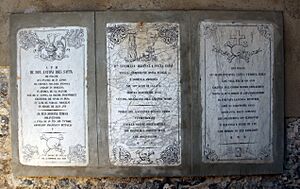
Many Sardinians share common family names like Sanna, Piras, and Melis. These names come from the Sardinian language and developed during the Middle Ages. They often describe a place, an animal, a job, or a personal trait. For example, Porcu means "pig," and Mannu means "big."
Over time, some Sardinian surnames became more Italian-sounding. Some names also came from Corsica, Italy, and Spain.
| Most common surnames | |
| 1 | Sanna |
| 2 | Piras |
| 3 | Pinna |
| 4 | Serra |
| 5 | Melis |
| 6 | Carta |
| 7 | Manca |
| 8 | Meloni |
| 9 | Mura |
| 10 | Lai |
| 11 | Murgia |
| 12 | Porcu |
| 13 | Cossu |
| 14 | Usai |
| 15 | Loi |
| 16 | Marras |
| 17 | Floris |
| 18 | Deiana |
| 19 | Cocco |
| 20 | Fadda |
Sardinians also had their own traditional first names, like Baínzu (Gavin) and Elianora (Eleanor). However, today most Sardinians use Italian first names.
How Sardinians See Themselves
Studies have asked Sardinians how they see their own identity. One survey found that:
- 26% felt only Sardinian.
- 37% felt more Sardinian than Italian.
- 31% felt equally Sardinian and Italian.
- 5% felt more Italian than Sardinian.
- 1% felt only Italian and not Sardinian.
Another poll in 2017 showed that 51% of Sardinians felt most connected to being Sardinian, compared to 19% who felt most Italian.
Sardinian Culture
Languages Spoken in Sardinia
Italian is the most common language spoken in Sardinia today. It was introduced by the House of Savoy in 1760.
However, Sardinian (sardu) is the island's native language. It developed from Latin after it replaced an older language called Paleo-Sardinian. Some words and place names from Paleo-Sardinian can still be found today. Because Sardinia was ruled by different powers, the Sardinian language became divided into different dialects.
In recent years, there has been a movement to bring back Sardinian language and culture. The Sardinian language is now recognized as a minority language in Italy. About a million Sardinians can still speak it to some degree. However, because Italian was strongly promoted in schools, fewer young people speak Sardinian fluently today. It is considered an endangered language.
Other languages spoken in Sardinia include Sassarese and Gallurese dialect (which are related to Tuscan), Algherese Catalan (a dialect of Catalan), and Ligurian Tabarchino. These languages were brought by different groups who settled on the island over the centuries.
The Sardinian Flag
The official flag of Sardinia is called the Four Moors. It has a St George's Cross and four black heads wearing white bandanas. No one knows for sure where it came from, but it might have started in Aragon (Spain) to celebrate a victory against Moorish invaders.
Sardinia's Day
Sa die de sa Sardigna (Sardinia's Day) is a holiday celebrated every year on April 28th. It remembers a revolt that happened from 1794 to 1796. During this time, Sardinians rebelled against the feudal system and forced the Savoyard officials out of Sardinia. The king had refused to give the island more freedom, even after Sardinians helped defeat the French. This holiday has been officially recognized since 1993, and schools are closed on this day.
Religion
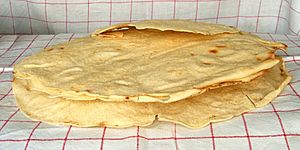
Most Sardinians are Roman Catholic. However, fewer Sardinians attend church regularly compared to other parts of Italy. Our Lady of Bonaria is the Patron Saint of Sardinia.
Traditional Clothes
Sardinian traditional clothes are very colorful and unique. They are an old symbol of identity and an important part of Mediterranean culture. While the basic style is similar across the island, each town has its own special clothing. These clothes were once worn every day, but now they are mostly worn for special events.
In the past, clothes even showed a person's marital status or social role. Until the mid-20th century, traditional costumes were still daily wear in many parts of Sardinia. Even today, you might see elderly people wearing them.
The clothes are made from various materials like Sardinian wool (orbace), silk, linen, and leather. Women's clothes include a headscarf (mucadore), shirt (camisa), bodice (palas), jacket (coritu), skirt (unnedda), and apron (farda). Men's clothes include a cap (berrita), shirt (bentone), jacket (gipone), trousers (cartzones), a skirt-like garment (ragas), and an overcoat (gabbanu). The mastruca, a sleeveless leather jacket made from sheep or goatskin, is especially linked to Sardinians. Ancient writers like Cicero even called Sardinians "Sardinians with rough wool cloaks."
Food and Music
Sardinia has its own unique food and music.
Sardinian Genetics
Sardinians are special in the European genetic landscape. Studies of ancient and modern DNA show that today's Sardinians mostly come from early farmers who lived there long ago. They also have some genes from later groups who settled on the island. The highest amount of these ancient farmer genes is found in the mountainous area of Ogliastra.
Scientists have studied Sardinian genetics to understand why they are more likely to get certain health conditions. These conditions might be linked to the island's isolated population, where certain genes became more common.
Comparisons show that Sardinians' genes are quite similar to those of early Neolithic people from the Alps and other parts of Europe. This suggests that while many parts of Europe saw big changes in their populations over time, Sardinia was less affected. Sardinians seem to have kept more of the genetic legacy of Western Europe's first farmers.
Recent studies suggest that Sardinians are not all genetically the same. There are some differences between people from different villages and regions on the island. For example, people from the isolated mountainous area of Ogliastra are genetically more distinct from other Europeans than those from coastal areas. This is because the coastal areas had more people moving in over time.
Despite these small differences, other studies show that Sardinians generally share a lot of genetic similarities across the island.
Y-DNA and mtDNA Studies
About 70% of Sardinian males belong to certain Y-DNA haplogroups (genetic groups passed down from father to son). These include I2 (especially I2a1a-M26), R1b-M269, and G2a. These groups are linked to early hunter-gatherers, steppe herders, and farmers.
Like most of Europe, the most common mitochondrial DNA haplogroup (passed down from mother to child) in Sardinia is H.
Famous Sardinians
Images for kids
- Sardinian traditional clothes and masks
-
Children from Ovodda
-
Urthos mask of Fonni
-
Robes from Maracalagonis
-
Woman from Ollolai
-
Robes from Cagliari
-
Robes from Busachi
-
Robes from Olbia
-
Robe from Sennori
-
Daily traditional clothe from Dorgali
-
Folk robes from Quartu Sant'Elena
-
Robes from Selargius
-
Robes from Assemini
-
Child from Aritzo
-
Women dressed in traditional Sardinian clothing (Quartucciu)
-
Robes from Settimo San Pietro
-
Robe from Dolianova
-
Men from Lanusei
-
Robe from Nuragus
-
Robe from Bultei
-
children from Villanova Monteleone
-
Knights from Teulada
-
Traditional robe from Laconi
-
Robe from Tonara
-
Robes from Fonni
-
A Mamuthone and an Issohadore, traditional carnival garments from Mamoiada
-
Sardinian knights on Sa Sartiglia day (Oristano).
-
People in traditional dress (Busachi)
-
Robe from Orgosolo
-
Sardinian men and children in traditional dress at the Sagra del Redentore (Nuoro)
-
Children from Ovodda in traditional dress
-
An Issohadore, typical mask of the Sardinian carnival (Mamoiada)
-
A Mamuthone, another typical mask of the Sardinian carnival (Mamoiada)
-
Boe and Merdule (Ottana)
-
Sardinians in traditional dress (Orgosolo)
-
Robe from Atzara
-
Robe from Oliena
-
Robe from Orune
-
Man from Austis
-
Robe from Ittiri
-
Woman from Fonni
-
Robe from Sassari
-
Robe from Cossoine
-
Robe from Isili
See also
 In Spanish: Pueblo sardo para niños
In Spanish: Pueblo sardo para niños
- List of Sardinians
- Sardinia
- History of Sardinia
- Nuragic civilization
- List of Nuragic tribes
- Sardinian language
- Sassarese
- Gallurese
- Sardinian surnames
- Corsican people
- Italian people
- Spanish people



